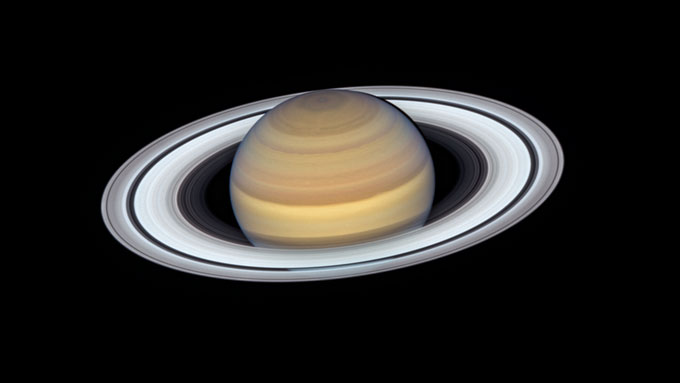What Is The Elemental Makeup Of Jupiter's Atmosphere?
Jupiter may have formed in a shadow — 1 colder than Pluto. Such a frigid birthplace could explain the giant planet's unusual abundance of sure gases. That'south the determination of a new written report.
Jupiter consists mostly of hydrogen and helium. Those were the near common elements in a planet-spawning deejay that spun around our newborn sun. Other elements that were gases near Jupiter's birthplace became function of the planet, too. And they would be present in the same proportions as existed in the deejay of planet-forming materials. It's known as the protoplanetary (Proh-toh-PLAN-eh-tair-ee) deejay.
Astronomers think the dominicus's composition largely reflects the protoplanetary disk'southward. And then Jupiter'southward elemental recipe should resemble the sun's — at least for elements that were gases. Simply the gases nitrogen, argon, krypton and xenon are some three times as common on Jupiter (relative to hydrogen) every bit they are on the sun. Why?
"This is the main puzzle of Jupiter'southward atmosphere," says Kazumasa Ohno. He's a planetary scientist at the University of California, Santa Cruz.
If Jupiter was born at its electric current distance from the dominicus, its birthplace would have been a frosty 60 kelvins. That'due south –213˚ Celsius (-351.4˚ Fahrenheit). And at that temperature, those elements should be gases. Beneath near thirty kelvins, however, they would freeze solid. It'south easier to build up a planet from solids than from gases. So if Jupiter somehow arose in a identify much colder than its electric current home, information technology could have acquired an icy mass containing bonus amounts of those otherwise gassy elements.
Two years agone, in fact, 2 different inquiry teams each offered upward this radical idea: that Jupiter originated in a deep freeze across the current orbits of Neptune and Pluto. After, they suggested, information technology could have spiraled in toward the sunday.
Ohno has at present teamed up with astronomer Takahiro Ueda at the National Astronomical Observatory of Nihon in Tokyo to propose a unlike idea. They argue that Jupiter could accept formed where it is. But the region would have been a lot colder dorsum so. They call back a pileup of dust could have formed between the planet's orbit and the dominicus. This would have blocked the sun's warming calorie-free.
That would have cast a long shadow, 1 that imposed a deep freeze on Jupiter's birthplace. The ultracold temps would have made nitrogen, argon, krypton and xenon freeze solid. And this would have allowed them to get a larger role of the planet.
The scientists draw their thought in a new study. It appears in the JulyAstronomy & Astrophysics.
Enter snowballs
Where would that dust accept come from? Ohno and Ueda think it could have been debris left when rocky objects closer to the sunday collided and shattered.
Farther from the sun — where the protoplanetary deejay was colder — water froze. This would take given rise to objects that resembled snowballs. When they collided, they were more likely to stick together than shatter. Thus, they wouldn't cast much of a shadow, the researchers say.
"I think it's a clever ready" to explain what would otherwise be difficult to explain, says Alex Cridland. He's an astrophysicist. He works at the Max Planck Establish for Extraterrestrial Physics in Garching, Germany.
Cridland was one of the scientists who had suggested Jupiter likely formed beyond Neptune and Pluto. Only that theory, he says, means Jupiter had to move much closer to the sunday after its birth. The new scenario, he says, nicely avoids that complication.

How to test the new idea? "Saturn might agree the key," Ohno says. Saturn is well-nigh twice as far from the sun every bit Jupiter is. The grit shadow that could have chilled Jupiter's birthplace would barely have reached Saturn'southward, Ohno and Ueda have calculated.
If true, Saturn would take arisen in a warmer region. So this gas behemothic should not have acquired nitrogen, argon, krypton or xenon ice. In dissimilarity, if both Jupiter and Saturn really formed in the cold beyond the present orbits of Neptune and Pluto, then like Jupiter, Saturn should have lots of those elements.
Astronomers know the composition of Jupiter. They learned when NASA's Galileo probe dove into Jupiter'south atmosphere in 1995. What's needed, Ohno and Ueda say, is a similar mission to Saturn. NASA's Cassini spacecraft did orbit Saturn from 2004 to 2017. However, it measured only an uncertain level of nitrogen in the Ringed Planet'southward atmosphere. It plant no argon, krypton or xenon.
Source: https://www.sciencenewsforstudents.org/article/jupiter-chemistry-shadow-origin-planet-space-temperature
Posted by: axelsongairineyers.blogspot.com


0 Response to "What Is The Elemental Makeup Of Jupiter's Atmosphere?"
Post a Comment